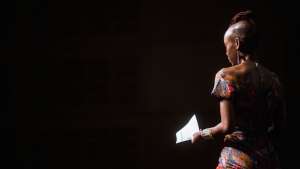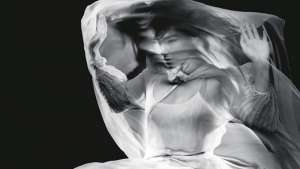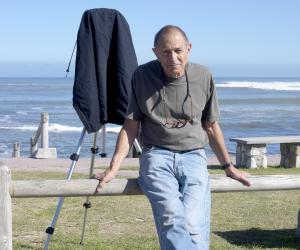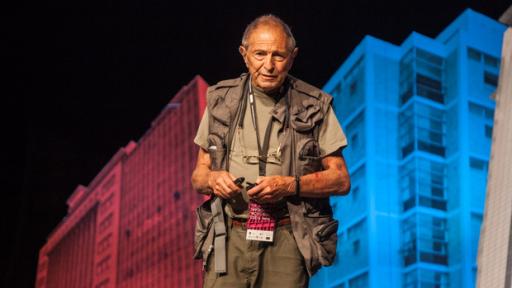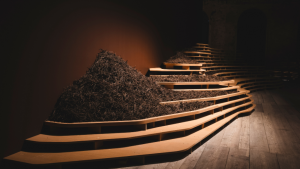Photographer David Goldblatt takes the audience at Design Indaba Conference 2014 on a moving journey through 20 images dating from as far back as 1964 and ending with a photo taken less than a week before his presentation.
Many of the images are portraits, unrelated to each other but through which Goldblatt weaves a common narrative of the complex nature and identity of people, and the conflicted history of South Africa.
The first image he shares is of a commando of National Party stalwarts, which escorted Prime Minister and National Party leader Hendrik Verwoerd and his wife, Betsie, to the party's 50th anniversary celebrations at De Wildt in the old Transvaal. The photo was taken in October 1964 and shows, among others, Leon Wessels, who went on to become a Deputy Minister of Justice in the National Party cabinet.
“A lot of the photographs that I am going to talk about have what we in Afrikaans call ‘’n ingewikkelde kwaliteit’ or a kind of involuted complexity,” Goldblatt says.
Wessels, who appears in the middle of the commando photograph, was the first senior Nationalist to apologise for Apartheid and today works as a human rights lawyer.
“So the obvious, is not necessarily the obvious,” he muses.
Next is a photo, reminiscent of the work of Dorothea Lange, of a farmer who sits with “great delicacy” smoking a pipe on the threshold of a house in Die Hel, a remote farming community in the Gamkaskloof. Goldblatt notes he found it curious that almost none of the largely white farming community living here had heard of the racist epithet “kaffir” so commonly used during the Apartheid era.
He then shows a portrait of Steven le Roux, a sheep farmer in the Koffiefontein area of the Free State by day, and writer of highly acclaimed Afrikaans novels (including one banned during Apartheid) under the name of Etienne Leroux by night.
In the 1960s Goldblatt photographed the gold mines of the Witwatersrand and its miners. With the permission of the AngloGold mining corporation he visited one of its big hostels, Western Deep Level.
“When I arrived, to my shock, the compound manager had instructed every tribal group in the compound to present themselves to me in tribal attire,” he says. “I was about to pack up my things and go back home – I did not want to make ethnographic photos – when I saw that the men actually took this very seriously. That they presented themselves to me with great dignity.”
He shares a mining portrait of a so-called “Boss Boy” or team leader, the highest rank that a black man could rise to in the mining industry then. The photo was taken at Randfontein Estates, Goldblatt’s hometown, of a man who shows all the paraphernalia of the position.
Next is a portrait of Margaret Mcingana, who later became famous as the singer Margaret Singana, taken in her house in Zola, Soweto. She is reclining on a bed againt the backdrop of a vast, marked wall. The photo heralded the start of a series on Soweto.
“The photograph was taken as an attempt at an essay on Soweto in the early 1970s. I had suggested to the editor of Optima magazine that they do the essay. At that time this vast complex of townships was hardly know to South Africans, in particular to white South African.”
Goldblatt suggested that fellow photographer Peter Magubane should do the assignment but he was taken in to solitary confinement and banished so he, accompanied by poet and friend Sipho Sepamla, went to Soweto to shoot the essay.
“This was the first photograph that I did there and it became for me a kind of icon of the township, because the township was a very strange place. It was not a slum. People think it was a slum; it wasn't a slum. It was a vast series of government-built houses. And these houses were designed specifically to discourage people from putting down roots. They wanted people who lived here to be labourers in the so-called white economy and to go back home to their tribal homelands. So that wall, that hellish wall, was a symbol to me of the claustrophobic tightness of that place.”
Also included in the Soweto essay is an image of two young men. When Goldblatt approached them to take the photo, one of them without hesitation took out his “dompass” – an identification document all black people over the age of 16 had to carry with them at all times. What surprised the photographer was the delicacy with which the youth held the document – it was not an aggressive or confrontational gesture.
A particular passion of Goldblatt is the physicality of people and in 1975 he embarked on a series that became, in his words, “obsessional for about six months”.
“The physicality of people impressed me deeply," he says. “Their limbs and the way they held themselves. I was obsessed with parts of people’s bodies. And I took these photographs thinking when I began them, that they would for once be something lyrical I could do. That it would be an expression of my own sensuality and sexuality and my interest in people. But inevitably, without ever meaning to or looking for it, it also had political overtones.”
He goes on to show several portraits of people he had shot during this time, including a one-eyed house painter relaxing in a pair of shorts at home in Hillbrow, a photo of the soft fold of flesh on the thigh of a woman smoking and the intertwined hands of a man sleeping in Joubert Park wrapped protectively around his head.
Next up is an image of a young ballerina in a tutu on the “stoep” of her home in Boksburg.
“She was, for me, the apotheosis of the young white woman trapped in the rigidity of white middle-class life at that time,” he reflects.
Another portrait is that of Wendy Orr, a 23-year-old doctor posted to Port Elizabeth to work in the District Surgeon’s department who exposed the torture conducted by security police in prison.
During this time Goldblatt became interested in photographing people who were held in detention and tortured by the police. But as was typical of the era, information was censored and controlled by the police so his access was limited.
He shows the image of 15-year-old Lawrence Matjee after his assault and detention by the security police. The photo was taken in 1985 at Khotso House, the headquarters of the South African Council of Churches (SACC) in De Villiers Street, Johannesburg that was bombed three years later for harbouring anti-Apartheid groups.
“I felt, in him, a kind of compassion,” he recalls of the young man. “There was no hate. To my shame and regret I don't know what happened to him."
In a rare display of his professional commissions with his personal work, Goldblatt shows a portrait of President PW Botha at the Union Buildings in Pretoria taken for Leadership magazine.
“You had to be a master of the situation otherwise you wouldn't get a good photograph,” he says of his approach to photographing high-profile people, especially Presidents.
When photographing Nelson Mandela, for example, he insisted on seating him in a straight-back kitchen chair instead of the more luxurious, deep armchair proposed by the press secretary.
“If you want to destroy a politician, that is one of the best ways of doing it [seated in a deep armchair] because he becomes all knees,” he explains.
The portraiture work led to an interest in photographing nudes. “I didn't want to do nudes as nudes," Goldblatt says. "I wasn't after doing some beautiful bodies. I wanted to do photographs of people as I found them. I wanted to somehow find people in the nude but of course one generally doesn't just find people in the nude, and so I thought about this and it didn’t go anywhere. “
This in turn led to the idea of photographing “experienced bodies”, bodies that had seen life, women who had given birth, men who had been in action or wounded. For the cover of a book of poems by Antjie Krog on sexuality in older people, he shot a series of nude photos.
Using his camera to understand his surroundings better – in this case to “come closer to [the] phenomenon” of crime, often violent crime, in South Africa – Goldblatt took on a series about people who had been in trouble with the law. He wanted to encounter them as ordinary people so he asked them to return to the scene of the crime and to tell him the story of their lives. Here he shares the back-stories to two of these portraits.
Lastly, he shows a picture of “The Thinking Stone”, a sculpture by South African artist Willem Boshoff on the campus of the University of the Free State. The artwork is part of a series the university commissioned to expose students to new ideas and stimulate healthy interaction in the aftermath of a much-publicised incident in which a group of male Afrikaans students urinated into the food of black workers.
"It is not what I would call a conventional portrait," Goldblatt says. “I consider it to be a thinking stone in the sense that it challenges us to think about where we are in this country and what kind of people we are. So for me it is an almost ultimate portrait."

